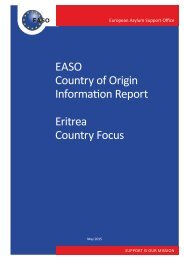o94lwpv
o94lwpv
o94lwpv
Create successful ePaper yourself
Turn your PDF publications into a flip-book with our unique Google optimized e-Paper software.
Ferede and Ofosu-Mensah 048<br />
the basis of Article II of the Paris Peace Treaty, which<br />
stipulates that „if the four states could not reach an<br />
agreement on the liquidation of any of [Italian colonial<br />
territories] within a year of implementing the peace treaty<br />
with Italy, then the matter would be referred to the<br />
General Assembly of the United Nations to make<br />
recommendation concerning it, and the four states agree<br />
to accept the recommendation and to take the necessary<br />
measures to implement it (Othman, 1974: 215). Then, the<br />
UN assigned five men from Guatemala, Norway,<br />
Pakistan, South Africa and Burma to conduct a need<br />
assessment about the interests of the peoples of Eritrea.<br />
After a rigorous assessment, still unanimity was<br />
impossible and three options were presented to the UN.<br />
Guatemala and Pakistan recommended guaranteeing<br />
independence whereas Burma and South Africa called for<br />
federation. Norway alone recommended union (Bahru,<br />
2002: 183). The result of this investigatory process<br />
reflects each country‟s diplomatic and religious affinity<br />
either with Ethiopia or Eritrea in lieu of declaring the true<br />
will of the populace. 2 In spite of this lacuna, the UN<br />
General Assembly adopted resolution 390V on 2<br />
December 1950. Accordingly, Eritrea became an<br />
autonomous unit federated with the Ethiopian crown<br />
(Bahru, 2002: 183).<br />
THE ADOPTION AND DISSOLUTION OF THE<br />
FEDERATION<br />
Historians are not unanimous with a single and definite<br />
point in explaining the rationale for adopting the federal<br />
formula for addressing the decolonization complexities of<br />
Eritrea. Some historians like Bahru argue that the<br />
federation was a compromise and golden mean of<br />
antithetical and irreconcilable interests of the separatist<br />
and unionists (Ibid). According to him, under the then<br />
condition the federal formula was the best of all<br />
alternatives in spite of the hard line advocacy of external<br />
powers. This view is completely ruled out by Yohannes<br />
who rather argues about the predisposition of the<br />
federation towards the unionists (Ibid).<br />
He further consolidates his argument by exemplifying<br />
the conflict between the unionist and the separatist after<br />
the resolution. In fact, neither the separatist nor the<br />
unionist was satisfied with the resolution. The author<br />
contends that the total democratization of the pre-colonial<br />
Eritrean-Ethiopian state with social action was the way<br />
forward than being an instrument of foreign interest with<br />
the guise of the „golden mean.‟<br />
Due to this situation, some others believe that the<br />
federation was foreign imposition dictated by the interests<br />
2 This indicates the failure of the peoples of the two regions to<br />
solve their own problem by themselves and thereby handed<br />
over the issue for external powers who were hovering for<br />
dominating the region. Thus, the final resolution was carefully<br />
calculated time bomb that benefits neither.<br />
of Britain and USA. Generally, the federal act was put into<br />
effect on 15 September, 1952 and culminated with the<br />
gradual incorporation of Eritrea that was finalized on 14<br />
November 1962 following the dissolution of it by<br />
members of the Eritrean Assembly ( Semere, 1988: 43).<br />
There is no accord among scholars in explaining the<br />
culmination of the federation as in its adoption. However,<br />
there are judgmental and multifarious disclosers given by<br />
different historians. Paul Henz emphasizes on the<br />
obsoleteness and proliferation of its dysfunctions as the<br />
main factor that brought about the dissolution of the<br />
federal act (Gilbert, 1962: 1), whereas Tekeste attributes<br />
it to the actions and aspirations of the Eritreans (Takeste,<br />
1997: 147). Conversely, many Eritrean nationalist<br />
scholars claim that the dissolution was a unilateral act<br />
taken by Ethiopian emperor who indulged himself in<br />
illegal task of rectifying Eritrean constitution to make the<br />
federation compatible with the incompatible imperial<br />
monarchical system (Yohannes, 1988: 194).<br />
THE SEPRATIST MOVEMENT AND THE SECESSION<br />
OF ERITREA<br />
Many scholars believe that it was the dissolution of the<br />
federation by the imperial government of Ethiopia and the<br />
deteriorating situation that gradually and inevitably led to<br />
an armed confrontation and full-fledged movement aiming<br />
at the complete independence of Eritrea. This argument<br />
bases itself on the remedial right theory of secession.<br />
According to this theory, secession right is a right that a<br />
group exercises it only as a result of violations of other<br />
rights. Thus, the right to unilateral secession is not<br />
primary but derivative upon the violation of more basic<br />
rights. Therefore, secession is justified only as a remedy<br />
of last resort for serious injustices and tyranny (Ibid: 36).<br />
Moreover, remedial right only theories allow that there<br />
can be special rights to secede if the state grants a right<br />
to secede implicitly or explicitly in its constitution or if the<br />
agreement by which the state was initially created out of<br />
previously independent political units included the<br />
assumption that secession at a later point was<br />
permissible. Different versions of remedial right only<br />
theories specify different lists of injustices that can ground<br />
the remedial right. The most common of this injustice<br />
includes large-scale and persistent violations of basic<br />
human rights, unjust taking of the territory of a legitimate<br />
state, the state‟s persisting violation of agreements and to<br />
accord a minority group limited self-government within<br />
the state. This approach to secession recognizes at least<br />
two ways a group can have a valid claim to territory: by<br />
reclaiming territory over which they were sovereign but<br />
which was unjustly taken from them or by a claim to<br />
sovereignty over the territory as a result of availing<br />
themselves of a last resort remedy against serious and<br />
persistent violations of basic human rights.<br />
In actual fact, it was a year before the dissolution of the<br />
federation that the Eritrean independence movement was<br />
formed. Thus, the author contends that instead of the






